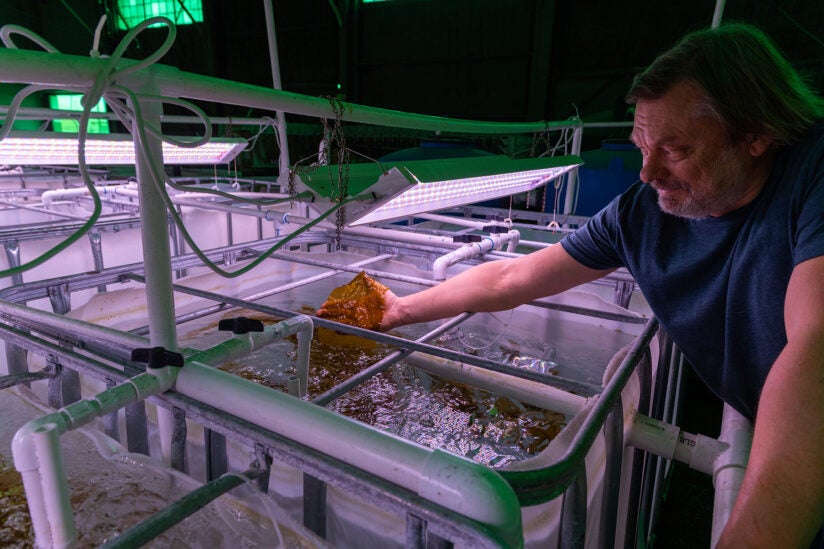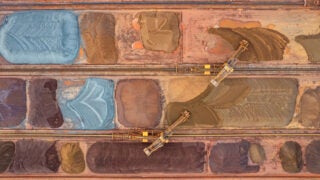Farms of the future: How the mung bean, chickpea and kelp can survive climate change?
USC Dornsife’s Sergey Nuzhdin on how the evolution of crops may point toward their sustainable future.
Cultivated for thousands of years, mung beans and chickpeas are two of the most vital crops on earth. The legumes are an essential source of protein to billions of people in Southeast Asia and the Middle East.
As climate change affects local, delicate ecosystems, it’s essential to develop new ways to grow these crops. An international team of researchers including Sergey Nuzhdin of the USC Dornsife College of Letters, Arts and Sciences is investigating how mung beans and chickpeas evolved in hopes of discovering ways to ensure the crops’ future.
We recently spoke to Nuzhdin, professor of biological sciences at USC Dornsife, about his research and his recent receipt of the President’s Sustainability Research Award.
You’ve had two recent papers on the evolution of mung beans and chickpeas — why is this research vital now?
The mung bean and chickpea are two of the most productive legumes and sources of protein for humans on the planet. For example, the chickpea originated in Turkey about 10,000 years ago. But most domesticated chickpeas come from a very limited genetic base. That means they lack traits which are responsible for drought resistance, dry root resistance or resistance to different diseases.
Our research for mung beans and chickpeas focused on going to native locations, getting samples and integrating those samples into varieties that make them suitable to a wide variety of environmental conditions.
How is climate change affecting these crops?
Our colleagues at the World Vegetable Organization in India and at National Taiwan University focused on the climate aspect of the study. We used that data to understand how the distribution of crops should be shifted to optimize future environmental conditions for production.
The same thing is happening in different countries across the world, including the U.S. As a result of climate change, new crops will be introduced for cultivation, and current crops will be redistributed. For example, rice production has been prominent in Northern California: However, the limited number of water sources in Northern California makes it unclear whether they’re still productive. So, the agricultural community is undertaking a substantial amount of work to understand how industry will look into the future and how farmers will survive the change in conditions.
What is next?

Ocean research is consuming a substantial amount of our attention now. We’re taking some of these approaches to try to make some useful progress in the ocean.
We have projects supported by the Advanced Research Projects Agency–Energy (Arpa-E), Sea Grant and NOAA (National Oceanic and Atmospheric Administration) for designing kelp which will represent efficient growth and will not be harmful to the environment. We’re specifically designing kelp that will grow, but not reproduce, and provide an essential food source for ocean life. Why? Because that removes the concerns about farmed kelp sending their genes into the natural population. This will enable safe cultivation of those crops in the ocean, which is necessary for regulators to permit big farms in the ocean.
Why do we need big farms in the ocean? Because we can produce less biomass on land and use that land for reforestation — which is important and very efficient for carbon sequestration.
You recently were named one of the first recipients of the President’s Sustainability Research Award to investigate sunflower sea stars — how does this research fit within this work?
Kelp in California have been decimated — bull kelp has lost 90% of its population and biomass. That was due to a confluence of factors. One is that water is warming, but another is that because urchins eat it.
Normally what happens is that kelp grow near these urchin barrens and the urchins eat “drift kelp,” or aged and shredded blades. But when there is not enough drift kelp, the urchins switch to eating live kelp, forming barrens off the coast of California. Urchin barrens are proliferating because the predators that would normally help control urchin density — sea otters and sunflower sea stars, or starfish — have been overhunted and wiped out by disease, respectively.
Southern California doesn’t have those sea stars anymore — you can search for them, it’s like 100% loss. So, nature conservancies are advocating for growing them and releasing them into the wild. It’s a difficult task because these species take years to reproduce, but we have to introduce them to help save kelp for us.


